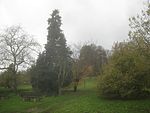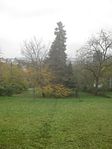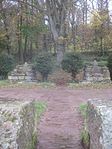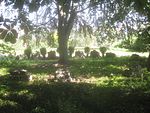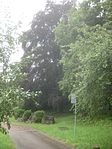At the beech
| At the beech | |
|---|---|
| Surname | At the beech |
| object | Landscape architectural installation |
| Artist | Karina Raeck (* 1938) |
| execution | ? |
| Construction year | 1993 |
| location | Stuttgart , Wartberg |
| Height above sea level | approx. 320 m |
| material | rough limestone |
| Dimensions | ? |
Next to the beech is a landscape architecture installation by landscape architect and photographer Karina Raeck on the Wartberg site in Stuttgart.
The treetop of a tall, mighty copper beech is traced on the earth by a circle of stone thrones and throne fragments . "These" petrified guards ", observatories over a historical landscape ... should bring the lost dialogue in our time between the built and the grown back to life." (Karina Raeck)
The Bei der Buche art station is one of the art stations that were set up for the 1993 International Horticultural Exhibition (IGA '93) in the green U park in Stuttgart and were retained after the exhibition.
Note: Numbers in brackets, e.g. B. (12), refer to the corresponding numbers in the plan of the Wartberg area.
location
The art station Bei der Buche (3) is on St.-Helens-Weg (17) on the Wartberg in Stuttgart. Further south you will find the art station Im Keuper (4).
The Wartberg is located in the Stuttgart-Nord district of Stuttgart and functions within the Green U , a closed green space eight kilometers in length, as a link between the Leibfriedschen Garten and Rosensteinpark in the east and the Höhenpark Killesberg in the west.
Access
The art station can u. a. can be reached on the following paths (paths 1 and 2 are also suitable for the disabled):
- From the Löwentorbrücke tram stop (20), go to Wartbergstraße, follow it to the clubhouse at Egelsee, then the Cardiffer Weg to the confluence with St.-Helens-Weg (17), which leads to the art station on the left.
- From the Höhenpark Killesberg you can get to the art station via St.-Helens-Steg (19), right over St.-Helens-Weg (17).
- From the Löwentorbrücke tram stop, follow the stairs to the Bombaystegen (21), turn right on the Kairoweg along the Egelsee (7) to the water playground and past the clubhouse at the Egelsee on the Cardifferweg. At the right bend, continue straight through the meadow, past a rest area with five groups of banks and a false cypress. From there, a former stone staggered track leads to a bastion wall in front of the art station.
description
From the false cypress to the copper beech
You can comfortably approach the art station from the side on St. Helens-Weg ( access , path 1 or 2), but it is more impressive if you choose the path from the false cypress to the art station ( access , path 3). Karina Raeck herself described this path, which leads up a meadow slope of approx. 20 m:
“The actual 'beech sanctuary' is only emphasized by the axial dialogue of a stone staggered trace between the beech and the false cypress standing on the hanging wall. Especially intended for the level of a loner, the stone staggered trail emerges as a historical relic of the former vineyards at the foot of the cypress and leads up the meadow slope through the opening bastion smauer, across the square through a ' yew gate' - and gradually loses itself in the The earth and foliage of the beech. "
According to the original plans of the IGA planning group around Hans Luz , "the axis of the bridge [Löwentorbrücke] ... should be aligned with the copper beech over a long, varied meadow of different widths". The plan failed due to the objection of the ecologists, against which the planning group could not prevail: "But for us planners was and is the elimination of a visually perceptible large meadow to the copper beech and a complicated path system ... still a sad smear on our basic concept." Visitors to the Wartberg therefore have to forego the panoramic view of the copper beech and laboriously search for the path to the false cypress and - if they can walk well - scramble up the slope to the copper beech from there.
The thrones
Some of the steps in the stone staircase that led up the former vineyard slope have survived the course of time and still lead to a breakthrough in the bastion wall, behind which there is a viewing platform. From there one arrives across a paved path to the "Eibentor", a passage to the copper beech, which is flanked by two yew bushes. On both sides of the Eibentor, stone thrones are lined up in a large circle that traces the outline of the beech crown on the ground - like an Arthurian round outdoors, with a meadow as a table and the copper beech as the grail in the middle, but the thrones turned outwards, as they are supposed to protect the copper beech as guards.
The massive thrones that line up between yew bushes on St. Helens Weg look more like deep, wide armchairs than high thrones. They are built from raw, uncut limestone, which gives them an archaic appearance. Away from the path, the now more sporadic thrones degenerate into fragments of themselves and mutate into stools or misshapen stone towers.
Behind the circle of the throne, a wide dry stone wall supports the slope that continues there towards Stresemannstrasse. A little further from the circle you almost stumble over an artificial, stone stump: the poetry station stabat mater purpurea with a poem by Ulrich Zimmermann that sings about the copper beech, which did not share the fate of its sisters felled by a hurricane .
concept
Karina Raeck based her installation on the following considerations:
- The beech, which is assigned the role of mother under the trees, has always radiated a mystical fascination for people. To raise the station Buche to a “beech sanctuary” would like to bring this lost consciousness back to memory. The beech as the center and supporting pillar between heaven and earth has already created its "cultic space" itself over an infinity of time. Humans can only pace it and, in accordance with the regularity of this tree, let them become aware of what is already there through spatial and substantive emphasis and deepening [...].
- Following the outer radius of the beech tree crown, a circle of archaic thrones and overgrown wall fragments that dissolve again in the forest thicket, which represent the “beech sanctuary”.
- These "petrified guards", observatories over a historical landscape, which suddenly transport the viewer across the domed rotunda of the Württemberg mausoleum to another century, are intended to bring the lost dialogue in our time between the built and the grown back to life.
literature
- Ralf Arbogast: Stuttgart, the green experience. Recreational landscapes, parks and garden shows in the past and present . Tübingen 1993, p. 92.
- Hans Luz: Around the Green U . Manuscript. Stuttgart 2012.
- Villa Moser, Hans Dieter Schaal. Stangenwald, Hans Dieter Schaal. At the crossroads, Claus Bury . In: Md: interior, design, architecture 40.1994, issue 2, pp. 62–65, here: 65.
- Frank R. Werner: The art concept: Art-Nature-Drama . In: Garten + Landschaft , 103.1993, issue 7, pp. 36–39, here: 38, 39.
- Frank R. Werner: Landscape and Art . In: Klaus-Jürgen Evert (editor): The permanent systems. IGA Stuttgart 1993 . Munich 1993, pp. 26-30, here: 26, 27-28.
- Frank Werner (ed.); Christof Luz (essay); Hans Luz (essay): Art-Nature-Drama. Earthworks beyond the IGA 1993 Stuttgart . Stuttgart 1993, pp. [23-27].
Web links
Individual evidence
- ↑ # Werner 1993.3 , p. [27].
- ↑ The ten art stations that have been preserved are: Near the beech, Bienengarten , Egelsee , Gate of Hope , Grottenloch , Im Keuper , Sanctuarium , Stangenwald , Unter den Stangen , Villa Moser .
- ↑ The plan is based on an OpenStreetMap map.
- ↑ # Werner 1993.3 , p. [27].
- ↑ #Luz, Hans 2012 , p. 67.
- ↑ # Werner 1993.3 , p. [27].
Coordinates: 48 ° 48 '15.9 " N , 9 ° 10' 32.6" E


